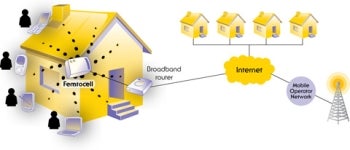The problem is familiar to many cell phone users: When you're indoors, even within your carrier's coverage area, the network's signal sometimes simply isn't strong enough to support voice calls or data services. With so many consumers ditching their landlines for cell phones, poor reception at home is no longer acceptable. Fortunately, a slew of products now address the problem, though they don't come cheap.
Ssignal-boosting products generally fall into one of two categories: femtocells or signal repeaters. Both types of equipment can deliver strong signals within buildings, but they work in fundamentally different ways.
Femtocells act as miniature cell phone towers that connect to a home network router and use your wired broadband connection to move voice calls and data services to and from your carrier's network. Femtocells don't rely on the carrier's towers at all, but because they use technology that can direct data and calls back to the carrier networks over the Internet, most of them are sold by the carriers themselves.
Repeaters and boosters, on the other hand, amplify and rebroadcast cell tower signals. Since they don't require carrier support, they tend to be manufactured and sold by third parties such as Wi-Ex (under the brand name ZBoost) and Wilson Electronics.
Understanding Femtocells
While repeaters have been around for several years, femtocells are relative newcomers to the mobile scene. Of the four major U.S. carriers, two--Sprint and Verizon--have been selling femtocells (under the brand namesAirave and Network Extender, respectively) for the past few years; AT&T introduced its 3G MicroCellfemtocell last year.
 AT&T's 3G MicroCell, made by Cisco. Image: AT&TThe first Sprint and Verizon Wireless femtocells supported only voice calls, but current models support high-speed data as well as voice. Sprint charges $130 for its Airave access point (with a two-year service plan); there's no additional charge for using Airave to enhance coverage with an existing plan, but Sprint does offer a $25-a-month unlimited calling plan for Airave calls--which might appeal to anyone who is considering dropping landline voice service. Current Airave access points support EvDO Rev. A 3G data speeds and up to six simultaneous calls.
AT&T's 3G MicroCell, made by Cisco. Image: AT&TThe first Sprint and Verizon Wireless femtocells supported only voice calls, but current models support high-speed data as well as voice. Sprint charges $130 for its Airave access point (with a two-year service plan); there's no additional charge for using Airave to enhance coverage with an existing plan, but Sprint does offer a $25-a-month unlimited calling plan for Airave calls--which might appeal to anyone who is considering dropping landline voice service. Current Airave access points support EvDO Rev. A 3G data speeds and up to six simultaneous calls.
Verizon Wireless charges $250 for its Network Extender, which also supports 3G data, and the carrier imposes no monthly service fee. AT&T sells the MicroCell for $150, also with no mandatory service fee; it also offer an optional $20-a-month unlimited calling plan, plus price breaks for customers who sign up for the company's DSL service.
The Beauty of the Femtocell
Femtocells appeal to consumers and carriers on several levels. Consumers like them because they provide immediate five-bar coverage across an area of up to 2500 square feet, regardless of how far you are from a cell phone tower. A strong signal typically means better voice quality, fewer dropped calls, and faster data speeds. Good signals also improve a phone's battery life, since its radios don't have to work as hard.
 Femtocells are low-power wireless access points that operate within a licensed spectrum to connect standard mobile devices to a mobile operator’s network via residential DSL or cable broadband connections. Image: Femto ForumAnother benefit: You can configure the femtocell to recognize and prioritize the phones you authorize, so neighbors can't mooch off your service at your expense. Interestingly, Verizon Wireless's FAQ for its Network Extender says that, though you can prioritize up to 50 Verizon Wireless numbers, the device will remain available to all Verizon Wireless subscribers within range when priority numbers aren't using it.
Femtocells are low-power wireless access points that operate within a licensed spectrum to connect standard mobile devices to a mobile operator’s network via residential DSL or cable broadband connections. Image: Femto ForumAnother benefit: You can configure the femtocell to recognize and prioritize the phones you authorize, so neighbors can't mooch off your service at your expense. Interestingly, Verizon Wireless's FAQ for its Network Extender says that, though you can prioritize up to 50 Verizon Wireless numbers, the device will remain available to all Verizon Wireless subscribers within range when priority numbers aren't using it.
This brings us to a big reason why wireless providers like femtocells: They offload some of the expense that the carriers might otherwise incur in order to expand network capacity and/or coverage. Femtocells also help retain customers in locations where carriers can't significantly improve reception on their own (such as basements, suburbs that don't want new cell towers, locales with difficult topography such as steep hills and valleys, and skyscrapers with thick walls). In fact, forum posts indicate that Sprint has occasionally given customers Airave units to keep them from switching to another carrier.